

– divulgazione scientifica. Scuola Ambulante di Agricoltura – il pensiero che fa, il fa che pensa. River basins in Italy : Maps. The Regenerative Agroforestry Podcast. Twelve leverage points. The twelve leverage points to intervene in a system were proposed by Donella Meadows, a scientist and system analyst focused on environmental limits to economic growth.[1] Contents History[edit] The leverage points, first published in 1997, were inspired by Meadows' attendance at a North American Free Trade Agreement (NAFTA) meeting in the early 1990s, where she realized a very large new system was being proposed but the mechanisms to manage it were ineffective.
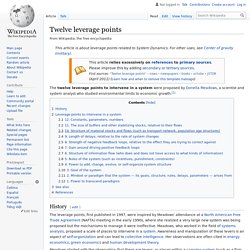
Meadows, who worked in the field of systems analysis, proposed a scale of places to intervene in a system. 20 Vegetables You Can Re-Grow From Scraps. How To Grow Blueberries In Pots. It does not matter whether you have a large property, a tiny garden, or no garden at all, container gardening is a great solution for growing a range of different plants.

Blueberries are one edible crop that does well when grown in containers, so in this article, we’ll take a look at how to grow blueberries in pots. Related Reading: 20 Fruit Canes Or Bushes To Grow In Your Garden. Home - Geoportale Nazionale. Carte IGM di tutta l’Italia on line – Cose&Robe – Rielaborazioni dataset opendata – @gbvitrano. Understanding the Two Sides to Soil Organic Matter Can Help Us Improve Soil Health – On Pasture. This story comes to us from Anne Manning at Colorado State University.
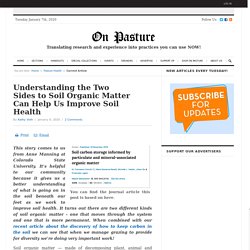
It’s helpful to our community because it gives us a better understanding of what is going on in the soil beneath our feet as we work to improve soil health. PHC Film: Il suolo è un organismo vivente. There’s another story to tell about climate change. And it starts with water. It’s easy for all concerned about air, water and nature to descend into despair as we watch brazen rollbacks of environmental legislation in the US.
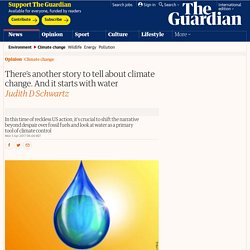
Just last week, developments included an executive order to rewrite US carbon emissions rules, jeopardising the country’s ability to uphold its Paris climate talk commitment; the end of a moratorium on new coal leases; and the green-lighting of a pesticide claimed to cause harm to children. But as apathy is not an option, let’s try to think beyond the usual strategies. For one, we can recognise that the way we talk about our environmental challenges has interfered with our ability to truly grapple with them: that we limit ourselves by creating too simple a story. Specifically, the story we tell about climate. Organic Farming Practices - Rodale Institute. Organic vs Conventional - Rodale Institute. Organic agriculture is a production system that regenerates the health of soils, ecosystems, and people.

Organic farmers rely on natural processes, biodiversity, and cycles adapted to local conditions rather than the use of synthetic inputs like chemical fertilizers, pesticides, and herbicides. GMOs are not allowed in organic. The difference between organic and conventional The essential difference between organic and conventional farming is that conventional farming relies on chemical intervention to fight pests and weeds and provide plant nutrition. That means synthetic pesticides, herbicides, and fertilizers. But it is worse than that. – Rosher dot net – the home of Incredibish. The Permaculture Research Institute. The Keyline Contribution to Permaculture Without Percival Alfred (P.A.)
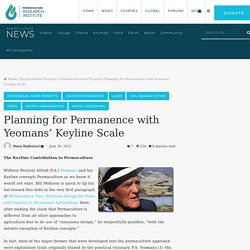
Yeomans and his Keyline concepts Permaculture as we know it would not exist. Bill Mollison is quick to tip his hat toward this debt in the very first paragraph of Permaculture Two: Practical Design for Town and Country in Permanent Agriculture. Regrarians. Siskiyoupermaculture.com/ Knowledge Base. Knowledge Base. Inputs and outputs in permaculture - Open Source Ecology. The Permaculture Design Process - An Example. Permaculture design methods and tools. Living Green and Frugally - Homesteading, DIY, Home, Gardening, - statistiche mondiali in tempo reale. Temperate Climate Permaculture. Principle Six - Produce No Waste. Applying Permaculture Principles to Livelihood Design. I am currently designing my livelihood & how I can meet my needs in the future.
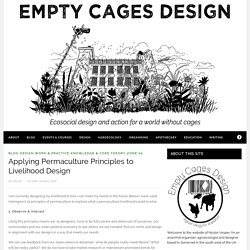
Below I have used Holmgren’s 12 principles of permaculture to explore what a permaculture livelihood could involve: 1. Permaculture Principles. Permaculture Design Principles. The foundations of permaculture are the ethics (centre) which guide the use of the 12 design principles, ensuring that they are used in appropriate ways. These principles are seen as universal, although the methods used to express them will vary greatly according to the place and situation. They are applicable to our personal, economic, social and political reorganisation as illustrated in the permaculture flower. Each principle can be thought of as a door that opens into whole systems thinking, providing a different perspective that can be understood at varying levels of depth and application. The Permaculture Research Institute. Llustration by Cecilia Macaulay Zone planning in permaculture design means placing elements according to how often we need to visit them.

Urban Zones & Sectors. Finding & Creating Microclimates. The term microclimate describes the climate of a small, specific place within a larger area.
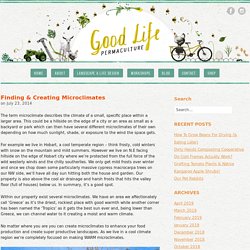
This could be a hillside on the edge of a city or an area as small as a backyard or park which can then have several different microclimates of their own depending on how much sunlight, shade, or exposure to the wind the space gets. For example we live in Hobart, a cool temperate region – think frosty, cold winters with snow on the mountain and mild summers. However we live on N.E facing hillside on the edge of Hobart city where we’re protected from the full force of the wild westerly winds and the chilly southerlies. We only get mild frosts over winter and once we chop down some particularly massive cypress macrocarpa trees on our NW side, we’ll have all day sun hitting both the house and garden. Our property is also above the cool air drainage and harsh frosts that hits the valley floor (full of houses) below us.
Within our property exist several microclimates. Microclimate - A Permaculture Design Course Handbook. In the book Introduction to Permaculture, Bill Mollison succintly present ways in which we can accentuate microclimates to enhance our systems.

Sepp Holzer, the Austrian Rebel Farmer, instilled much knowledge on this topic for me as well in 2009 during a workshop. Calculation of sun’s position in the sky for each location on the earth at any time of day [en] Home > Solar tools > Sun Position Insert this map tool in your site Back to top Content | Data + Map | Chart Polar | Chart Cartesian | Table | Annual sun path | download PDF Annual sun path.
UO SRML: Sun chart program. Data Services. (1) The Paradigm Shift leading to Survival and Sustainability. Carta topografica Via Gorgusello di Sotto. FM3-25.26 Chapter 10 ELEVATION AND RELIEF. Topographic Maps - Perry-Castañeda Map Collection - UT Library Online. Topographic maps. GeoExplorer - Geomap ARPAV. GeoExplorer - Geomap ARPAV. GeoExplorer - Geomap ARPAV. Quaderno bilancio idrico lug08. The Institute of Urban Homesteading – A Home-Grown Folk School of Urban Sustainability.
General circulation model. A type of climate model that uses the Navier–Stokes equations on a rotating sphere with thermodynamic terms for various energy sources Climate models are systems of differential equations based on the basic laws of physics, fluid motion, and chemistry. To "run" a model, scientists divide the planet into a 3-dimensional grid, apply the basic equations, and evaluate the results. Atmospheric models calculate winds, heat transfer, radiation, relative humidity, and surface hydrology within each grid and evaluate interactions with neighboring points.[1] This visualization shows early test renderings of a global computational model of Earth's atmosphere based on data from NASA's Goddard Earth Observing System Model, Version 5 (GEOS-5).
A general circulation model (GCM) is a type of climate model. GCMs and global climate models are used for weather forecasting, understanding the climate and forecasting climate change. Terminology[edit] History[edit] Atmospheric and oceanic models[edit] Explore Climate Anomalies, Variability, and Uncertainty in Space and Time with the Climate Inspector. Representative Concentration Pathways The climate change scenarios have been redesigned for the Intergovernmental Panel on Climate Change (IPCC) Fifth Assessment Report.
Previous SRES Emission Scenarios were designed to represent socio-economic development storylines and estimate associated emissions over the 21st century. Interactive Europe Koppen-Geiger Climate Classification Map. Europe Köppen Climate Classification Map Legend. Temperate climate. The different geographical zones of the world. The temperate zones span from either north or south of the subtropics (north of the yellow dotted line, at 40 degrees north) to the polar circles. Arpa.veneto.it/bollettini/storico/Mappa_2018_PREC.htm. Italy Interactive Plant Hardiness Zone Map. Hardiness (plants) Winter-hardy plants grow during the winter, or at least remain healthy and dormant.
AppleSeed Permaculture. Author’s Note: This is the original 8 Forms of Capital article from 2011. Weather Model - Global Jet Stream Wind and 250 mb Pressure (STORMSURF)